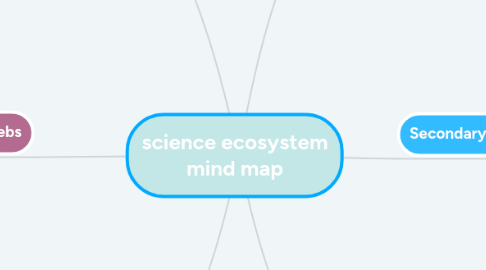science ecosystem mind map
by Talya Mamber

1. Food Chains
1.1. A food chain is a model that shows how energy and nutrients flow from one organism to another in an ecosystem.
1.2. Example: A producer may be consumed by a herbivore, which is then eaten by a carnivore. In some cases, another carnivore eats the first carnivore.
1.3. in a food chain can vary, but the food chain always starts with a producer and ends with a consumer.
2. Food Webs
2.1. Food chains show one producer being eaten by one consumer and perhaps another consumer eating the first consumer.
2.2. example: A squirrel eats several different types of seeds, fruits, and nuts. The squirrel may be eaten by a fox, a hawk, or a raccoon. The raccoon also feeds on frogs, clams, birds’ eggs, and corn. The fox will also eat mice and grasshoppers, the hawk will also eat frogs, mice, and snakes.
2.3. Most organisms are part of several food chains. A model that shows the connections between several different food chains is called a food web.
3. Habitat Loss
3.1. Habitat destruction occurs when natural habitats are no longer able to support the species present, resulting in the displacement or destruction of its home.
3.2. Examples: harvesting fossil fuels, deforestation, dredging rivers, bottom trawling, pollution, filling in wetlands and mowing fields.
4. Primary Succession
4.1. primary succession is one of two types of biological and ecological succession of plant life,occurring in an environment in which new succession of vegetation and other organisms usually lacking soil.
4.2. primary succession happens in areas where theres never been life.
5. Secondary succession
5.1. secondary succession is a process started by an event that reduces an already established ecosystem to a smaller population of species.
5.2. secondary succession is the slow change in species in a established community has been disturbed.
6. Ecological Footprints
6.1. ecological footprint is the impact of human activities measured in terms of the area of biologically land and water required to produce the good consumed.
6.2. a ecological footprint measures how much is needed to produce the resources we consume and dispose of our waste.


